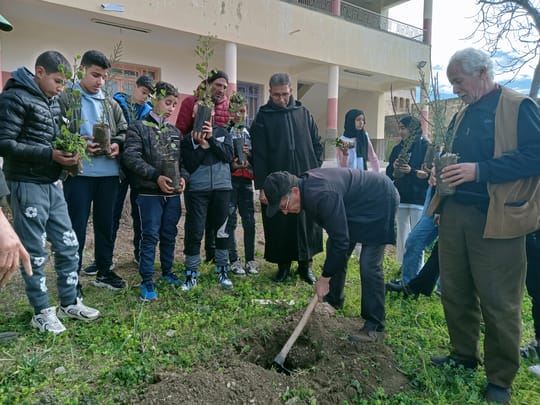Walnut Sapling Distribution in Chichaoua Province

By Luigi Limone
February 23, 2016
On February 22nd, I had the opportunity to accompany the HAF team to the province of Chichaoua, in the region of Marrakech-Safi. We left from Marrakech at 8 a.m. to reach the Tadmamt nursery. Immersed in the majesty of the High Atlas Mountains, the nursery imparts the feeling of peace and calm, compared to the chaotic life of Marrakech. There, Omar, who is taking care of more than 450,000 walnut and almond seeds, gave us 1,010 saplings to be delivered to ten schools in the Chichaoua province.
After loading the saplings in the car, we went on our way to Chichaoua. As weather became increasingly warmer, I experienced the feeling of passing from the freezing air of the Atlas to the dryness of long stretches of semi-empty fields in less than two hours.
When we arrived in Chichaoua, we were welcomed by the president of the “Association Atlas Initiative pour le Développement et l’Environnement” (A.I.D.E) and the representative for the Education Delegation of the province of Chichaoua. Unfortunately, they told us that the road to the ten schools was hardly passable due to the snow which hit the High Atlas Mountains last week. However, the saplings were temporarily planted in a school in the centre of Chichaoua and they will be delivered to the ten schools as soon as possible.
The representative of the Education Delegation of Chichaoua province was extremely pleased to take part in this project and she expressed her willingness to expand the tree distribution campaign to other schools, thus taking into consideration the climate specificities of the the different parts of the province. Besides walnut trees, which need to grow in cold temperatures, the province of Chichaoua has the potential to cultivate other products, such as olives and almonds.
As my first experience in the field, I was very impressed by the tree planting and distribution. The distribution of 1,010 saplings from the HAF team to the school and the cooperative effort to plant them exemplified the importance of working together and HAF’s engagement in establishing participatory projects for a more sustainable environment.